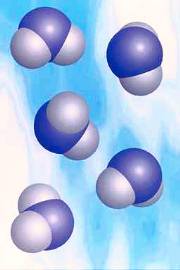5 October 2001
Submicrometer-Scale Metallic Barcodes
by Kate Melville
 Researchers at Penn State University and SurroMed, Inc., in the 5 October issue of the journal Science report on the fabrication, optical properties, and initial application of microscopic metallic barcodes. When coated with biomolecules, these patterned metallic particles enable the simultaneous monitoring of multiple biological reactions in very small volumes of fluid.
Researchers at Penn State University and SurroMed, Inc., in the 5 October issue of the journal Science report on the fabrication, optical properties, and initial application of microscopic metallic barcodes. When coated with biomolecules, these patterned metallic particles enable the simultaneous monitoring of multiple biological reactions in very small volumes of fluid.
The researchers prepare these barcoded particles by sequentially electroplating different metals within narrow channels to form metallic rods having complex striping patterns.
To read out the striping pattern, scientists take advantage of the fact that metals such as gold and silver reflect colored light differently. For example, silver looks much brighter under blue light than does gold, thus a gold-silver multistriped particle gives a pattern of light and dark stripes reminiscent of conventional barcodes of the sort used in the retail industry.
The researchers have prepared particles with stripes from 50 nanometers to 5 micrometers in length, with up to 13 different segments or 5 different metals. This flexibility means that it should be possible to create thousands of different distinguishable barcode patterns.
The scientists have coated particles of a given pattern such that they bind molecules of interest from solution. Thus, the particle striping pattern encodes the identity of the molecule to be detected on that particle.
The scientists then use a standard laboratory technique to determine the presence or absence of the specific molecules of interest. The researchers anticipate that barcoded particles will enable them to track and identify multiple biological components in clinical samples in a manner analogous to barcodes used in tracking inventory.
As a proof of principle for the use of these particles in bioanalysis, the scientists demonstrated their utility in two types of bioassays employing DNA and antibodies. Using an immunoassay protocol, they showed that it was possible to distinguish between human and rabbit antibodies on the basis of the barcode pattern.
In addition, experiments monitoring DNA hybridization demonstrated the potential for this technology in, for example, the detection of medically important errors in DNA sequences.
The paper, titled "Submicrometer Metallic Barcodes," describes work done in collaboration by Professors Christine Keating and Michael Natan, and their research groups in the chemistry department at Penn State, and by researchers at SurroMed working under the direction of Natan, who now is Chief Technical Officer there. SurroMed has obtained a broad and exclusive license from Penn State, and has copyrighted the term, NanobarcodesTM particles.
Keating says, "These particles represent a fundamentally new way to encode information on the submicron scale, which gives us more options for detection than previous techniques for particle encoding. The particles are easy to synthesize in what promises to be an incredible variety of distinguishable patterns.
This strategy could be a significant improvement over previous approaches, which have relied on combinations of fluorescent dyes for particle identification. In fact, for metallic barcodes it is possible to envision future detection schemes that avoid fluorescence altogether. The particles themselves are quite robust--unlike molecular fluorescent dyes, we have found that the metallic barcode pattern does not degrade even under intense, prolonged illumination."
Natan said, "Multiplexing has become a fundamental tenet of life science research. Scientists are no longer content merely to synthesize or measure one or even 100 species at a time. An excellent example is the gene chip, where it is possible to measure 10,000 different genes in parallel at a series of tiny spots on the chip surface. There has been a tremendous need for analogous technologies that operate in solution, and accordingly there has been substantial research and development effort in the area of encoded microparticles. However, the number of uniquely identifiable particles that could be prepared by previous methods was quite limited; with Nanobarcodes, we saw an opportunity to fabricate an essentially unlimited number of codes."
